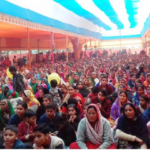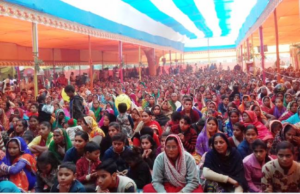Vinay Arya (General Secretary, Arya Samaj)
This is the story of the time when foreigners like Max Muller misinterpreted the meaning of the Vedas, the famous scriptures of the Sanatan Vedic religion, to serve the interests of the British government and Christianity. During that time, there was a discussion on how to convey the true meaning of the Vedas to foreigners. The matter was difficult. There were many Sanskrit scholars available, but the question was whether there was anyone who could translate the Vedas into English with their true meaning and commentary?

Only they knew how big a subject it was for other people of the country, but for an institution like the Arya Samaj and the followers of Rishi Dayanand, it was a matter of life and death. Discussions took place in meetings in Arya Samaj and finally a way was found…
What was this way and where did it end, let us know… In those days, there was a Pandit named Ganga Prasad Upadhyay ji. He was an Arya Samaji and was also a staunch devotee of Rishi Dayanand ji. He was also an English teacher in Bijnor Government Inter College. He did not have his own house, so he lived in a room in Bijnor Arya Samaj. During this time, the year was 1905 and it was the 24th of September, a son was born to him, he was named Satyaprakash.
As soon as the son grew up, Pandit Ganga Prasad Upadhyay was transferred and the family moved to Allahabad. He learnt English from his father and the son also followed his father’s path. Satyaprakash, who was very bright in studies, got his education from Allahabad University, and on the basis of his intellectual ability, he was appointed as a lecturer in the Chemistry Department of Allahabad University in 1930. His name was now changed to Dr. Satyaprakash.
In those days, high level books for science education in universities were mostly available in English written by British science professors. Whatever they wrote was considered to be true. Indian students or researchers could not read anything different even if they wanted to. Dr. Satyaprakash, being a teacher in the Science Department of Allahabad University, understood the needs of Indian students very well. So one day, understanding the pain of Indian students, he took a vow and wrote many useful books related to science in English. In the books written by him, he researched the science of ancient India in its various forms and created a sensation in the field of science by writing books like “Founder of Sciences in Ancient India”, “Quantums of Ancient India” and “Advanced Chemistry of Rare Elements”. After writing many important books in the field of science, Dr. Satyaprakash thought why not translate the Vedas into English. Dr. Satyaprakash started translating the four Vedas in 26 volumes into English. After translating the Vedas in the true sense, he also created literature like the introduction to Shatpath Brahman, explanation of Upanishads, Yogabhashya etc.
The year was 1942, India was trapped in slavery. Movements were going on in various names and forms. In those days, in the year 1942, he jumped into the freedom movement and also went to jail. After being released from here he travelled to about 17 countries and wrote a 700 page introduction on “Shatapath Brahman”, which is very helpful in understanding this great text completely.

Slowly time passed, the country got independence and in the year 1967 he retired from the post of Head of the Chemistry Department from Allahabad University. But after retirement he took Sanyas and became Arya Sanyasi Swami Satyaprakash Saraswati. That is, after retirement he took Sanyas and started living in a room in Arya Samaj Allahabad instead of his home. Or say, he moved forward following the path of his guru Dayanand Saraswati. He was so simple that Swami Ji wrote about himself, “I wake up in the morning. I bought a car, sold it and now I am using it on foot. I worked with Dr. Ram Krishnan, who was a famous scientist. I stayed in jail with former Prime Minister Lal Bahadur Shastri. I have written more in English than in Hindi. I have done the work of studying science, teaching science and editing books, pasting addresses on books and sending them by post.”
This was the reason that when in 1983, in the Third World Hindi Conference, the name of Swami Ji present at the event was called from the stage for the award, Swami Ji remained seated at his place among the audience. He had to go on the stage, but he did not go. When the famous Hindi poetess Dr. Mahadevi Verma Ji saw Swami Ji sitting far away, she understood the situation. She herself and her other colleagues came down from the stage and reached Swami Ji and honoured him there.
It is said that once Swami Ji Maharaj had come to Delhi from somewhere, at a time when his son was working in Delhi. He had to give some information, so Swami Ji Maharaj called his son’s office, then he came to know that his son has gone home. When he called his son’s residence, he came to know that he is ill, he had a heart attack.
Swami Ji remained sitting, kept thinking. Suddenly after some time, he came to know that his son had passed away. Swami Ji did not discuss this sad incident with anyone, did not express any grief and neither did he go home to attend the funeral. Meaning, he had taken sanyaas, left home, so he maintained the high tradition of Sanyas Ashram for the family as well.
When he was saddened by the death of his son, Swami Satyaprakash Saraswati had great affection for Mahatma Vedbhikshu, the president of Dayanand Sansthan, Delhi. He contacted him on phone. He said, “I feel like talking to you today, come to my room.” He kept discussing various things with him throughout the day. Two-three days after the funeral of his son, when his daughter-in-law came to Swami ji Maharaj, Swami ji, after talking to her for a while, said, “It is God’s will, whatever had to happen has happened, now you look after your work, I will look after my work.”
Only an immortal sanyasi can say these words. Only a disciple of Swami Dayanand ji can say these words. Otherwise, you must have seen the sanyasis of today, many are not able to leave the worldly and family attachment even after coming to Sanyas Ashram, but Swami Satyaprakash Saraswati ji followed the tradition which was started by his guru Maharshi Dayanand ji. That is, once he left home, he never returned.
Yes, once on the birth centenary of his father Pandit Ganga Prasad ji, Swami Satyaprakash Saraswati went to a program organized in Bijnor Arya Samaj and unveiled the stone on the building in Bijnor on 6 September 1981. Also, Swami Satyaprakash Saraswati ji got more than 22 students to do D.Phil during his teaching period. More than 150 of his research papers were published. It is said that before his death, Swami ji had a disciple Shri Dinanath Singh ji, resident of Amethi. The care and care his family provided him during his illness was commendable and exemplary. Apart from this, Shri Satyadev Saini of Lucknow and his family have been great devotees of Swami ji. A few days before his death, after getting treatment in Lucknow and being discharged from the hospital, Swami ji also stayed with Saini ji’s family for some time and after meeting all the members, went to Amethi. It was the month of January, 1995, the date was 18. On this day, Swami Satyaprakash Saraswati, who lived for 90 years, left for the eternal journey, leaving behind the favors he had done during his lifetime on Sanatan Dharma. Arya Samaj pays its salutations to Swami Satyaprakash Saraswati, the invaluable disciple of Maharishi Dayanand Saraswati.






More Stories
Who is the real king of Middle East Gulf countries?
Hyderabad Movement when Arya Samajis came out against Nizam
How are shrines and mosques growing in the lap of the Himalayas.